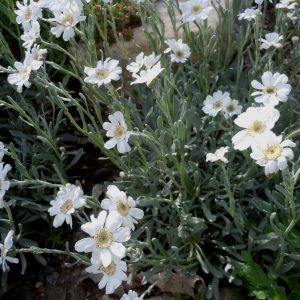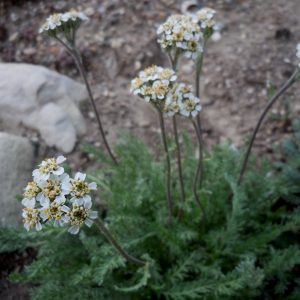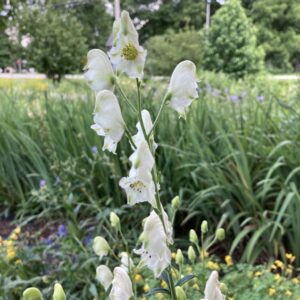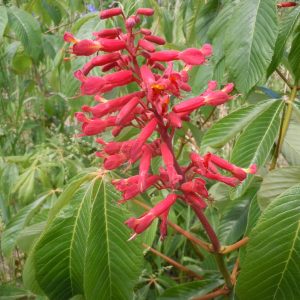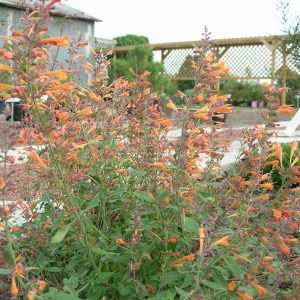Archives
Listing of plants we no longer grow, but have preserved the pages for informational use.
Showing 1–8 of 164 results
-
Achillea ageratifolia Greek yarrow Z 4-8
Silvery foliage smothered with porcelain white flowers June-August, fragrant
ARCHIVED
Note: This is a plant not currently for sale. This is an archive page preserved for informational use.
Silvery foliage smothered with porcelain white flowers June-August, fragrant
Size: 6”x 18”
Care: sun in dry to moist well-drained soil
Native: Balkans, Greece & Yugoslavia
Wildlife Value: Attracts butterflies, deer resistant.
Size: Good in rock garden & troughs.Achillea named for Achilles who used Achillea millefolium to bandage bleeding wounds for his soldiers. According to Philip Miller (1768) Achillea’s common name is “Nosebleed.” Ageratifloia means leaves like an Ageratum.
Collected before 1796. -
Achillea nana Dwarf yarrow Z 4-7
White flowers over grey-green foliage blooms for nearly 2 months in summer.
ARCHIVED
Note: This is a plant not currently for sale. This is an archive page preserved for informational use.
White flowers over grey-green foliage blooms for nearly 2 months in summer.
Size: 2-4” x spreading
Care: sun in well-drained to moist well-drained soil
Native: mountains of central EuropeCollected before 1753. Philip Miller’s The Gardener’s Dictionary (1768) wrote that it is a “native of the Alps…very hardy … will thrive in any soil (and) deserve(s) a place in gardens.” Achillea named for Achilles, hero of Homer’s Illiad, used Achillea millefolium to stop bleeding of his wounded soldiers at the siege of Troy. Achilles learned about the uses of Achillea from Chiron, the Centaur. Nana means “dwarf.”
-
Aconitum fischeri Fischer’s monkshood syn. A. carmichaelii
Spikes of cobalt blue hooded blooms September – October
ARCHIVED
Note: This is a plant not currently for sale. This is an archive page preserved for informational use.
Spikes of cobalt blue hooded blooms September – October POISON
Size: 24-36”x 10”
Care: part shade in moist soil
Native: No. Japan, E. Russia, Korea, China
Wildlife Value: Deer resistant. Attracts butterflies.The name Aconitum is from the mythical hill Aconitus in Pontica where Hercules fought with Cerberus. Philip Miller in The Gardener’s Dictionary (1768) wrote that the name Aconitum comes from Greek word for dart “because the Barbarians used to daub their darts therewith.” The Monkshood reputedly sprang from the jaws of Cerberus, the guard dog of the underworld. In China called “bao ye wo tou.” Wm. Robinson considered this one of the best monkshoods. Collected before 1820.
-
Aconitum napellus ‘Albus’ White Monkshood, Wolfsbane Z 4-8 POISON
Purest of white hooded blooms flowering along spikes in mid to late summer
ARCHIVED
Note: This is a plant not currently for sale. This is an archive page preserved for informational use.
Purest of white hooded blooms flowering along spikes in mid to late summer
Size: 2-3” x 18-24”
Care: part shade, cool, moist soil
Native: EuropeThe name Aconitum is from the mythical hill Aconitus in Pontica where Hercules fought with Cerberus. The Monkshood reputedly sprang from the jaws of Cerberus, the guard dog of the underworld. Believed to make a potion that helped witches fly. This was identified by Dioscordies in De Materica Medica for medicinal use around 70 A.D. Philip Miller in The Gardener’s Dictionary (1768) wrote that the name Aconitum comes from Greek word for dart “because the Barbarians used to daub their darts therewith.” He also considered “in flower it makes a pretty appearance.”Used by physicians in 1200’s and to poison wolves: “This Wolf’s bayne of all poisons is the most hastie poison.” Wm. Turner, 1560’s. Called Monkshood due to the shape of each flower like a monk’s hood.
This white variety in English gardens before 1768, Philip Miller’s Garden Dictionary -
Adiantum aleuticum Western Maidenhair Fern Z 3-9
Bright green fronds perch atop black stems like the fingers of an open hand
OUT OF STOCK
Bright green fronds perch atop black stems like the fingers of an open hand
Size: 30” x 30”
Care: shade in moist, well-drained soil
Native: East and west of the Cascade Mountains and is also found scattered along the eastern seaboard
Wildlife Value: Deer resistant
Awards: Elisabeth C Miller Great Plant Pick, Royal Horticultural Society Award of Garden MeritAccording to folklore if a girl can hold the stem without causing the leaves to tremble, then she was chaste.
Natives used the stems in basketry designs and made tea from the leaves to use as a hair wash. Quinault burnt the leaves and rubbed ashes in their hair to make it long, shiny and black. California Natives used the stems for pierced earrings, inserting them into the ear lobe to keep the hole from closing. They chewed the leaves to remedy internal wounds, chest pain, or stomach trouble and made a cough syrup from it. -
Aesculus pavia Red buckeye Z 5-8
Spectacular raspberry colored upright panicles in spring
ARCHIVED
Note: This is a plant not currently for sale. This is an archive page preserved for informational use.
Spectacular raspberry colored upright panicles in spring
Size: 15’ x 10’
Care: sun to part shade in moist well drained soil- understory tree
Native: eastern US
Wildlife Value: attracts butterflies & feeds hummingbirds
Awards: England’s Royal Horticultural Society Award of Merit; Pennsylvania Horticultural Society Gold Medal Plant Award & Missouri Botanic Garden Award of MeritAesculus is a Latin name for a nut bearing tree. Pavia comes from Peter Pav, a Dutch professor at University of Leyden. Native Americans used nuts from the tree to stupefy fish. Chickasaws pulverized the root, placed it in baskets and violently churned the baskets in the river to poison fish. Cherokee carried the nuts in their pockets for good luck, as well as for curing piles and rheumatism. Pounded nuts also cured swelling, sprains, tumors and infections This plant collected by John Bartram (1699-1777) and sent to England by 1711. Jefferson grew this at Monticello, planted in 1798..
-
Agastache aurantiaca Navajo sunset Z 5-9
Brilliant light orange blooms from spring-fall, silvery-grey aromatic foliage
ARCHIVED
Note: This is a plant not currently for sale. This is an archive page preserved for informational use.
Brilliant light orange blooms from spring-fall, silvery-grey aromatic foliage
Size: 12-18” x 24”
Care: sun in well-drained soil
Native: Western US
Wildlife Value: attracts bees, butterflies, hummingbirds, and birds. Deer and rabbit resistantPublished in American Midland Naturalist 1945.
-
Agastache rupestris Sunset hyssop Z 5-10
Tangerine & lilac spikes June - October, fragrant like anise
ARCHIVED
Note: This is a plant not currently for sale. This is an archive page preserved for informational use.
Tangerine & lilac spikes June – October, fragrant like anise
Size: 24”x 10”
Care: full sun in well-drained soil
Native: SW United States
Wildlife Value: Attracts bees, butterflies and hummingbirds
Awards: 1997 Plant Select award recipient.Collected by Edward Lee Greene in 1880 at Mango Springs neara Solver City New Mexico. Pittonia 1:164.
The name Agastache is from Greek agan and stachys meaning “much like an ear of wheat” referring to the shape of the flower spike. Rupestris means “rock loving.”

